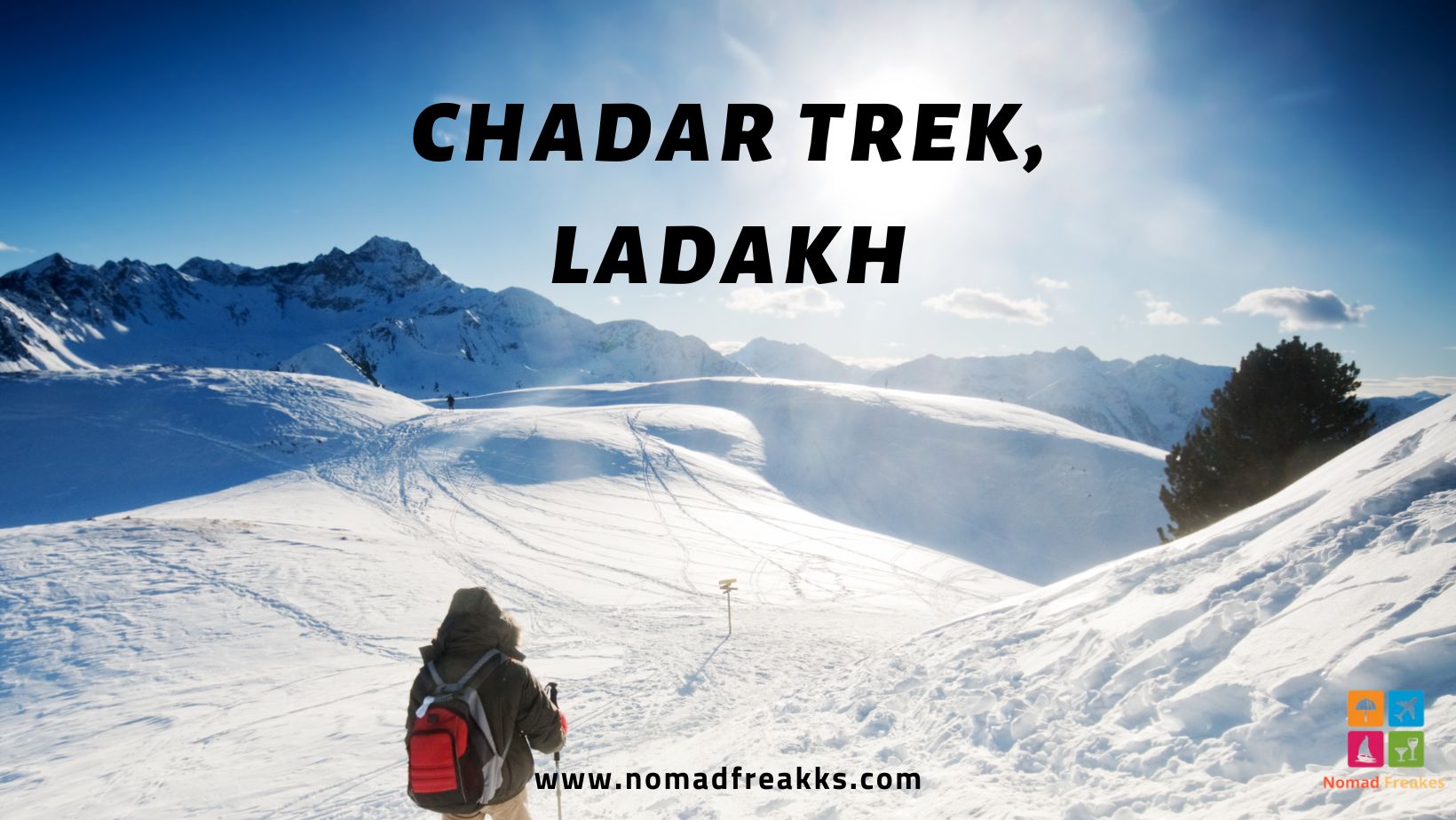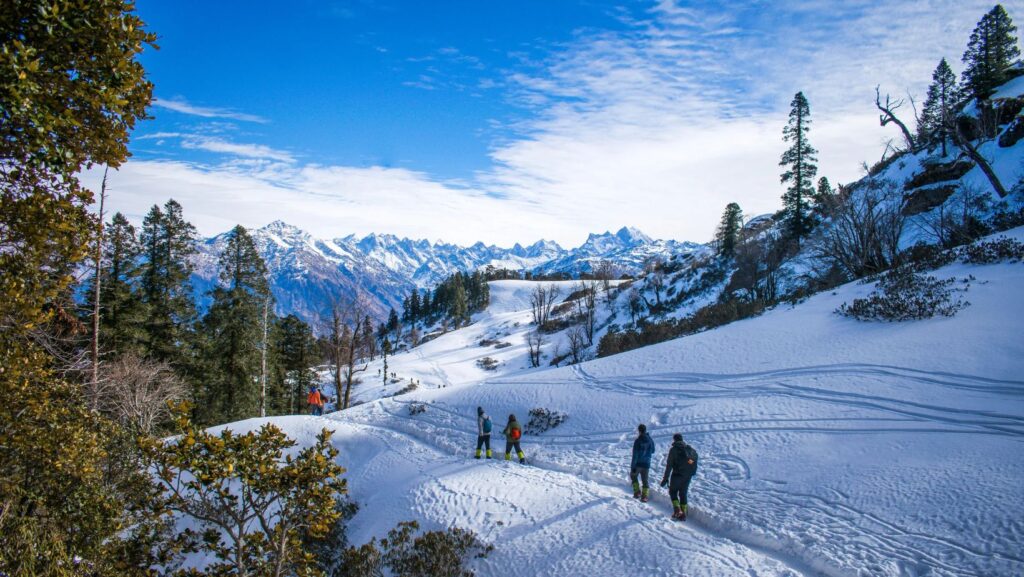Chadar Trek overview:
The Chadar Trek is a winter trekking expedition that takes place in the Zanskar region of Ladakh, in the Indian state of Jammu and Kashmir. The trek gets its name from the frozen Zanskar River, which is the main route of the trek.

The trek typically takes 9–10 days, covering a distance of approximately 105 kilometres. It is a challenging trek that requires a good level of physical fitness and acclimatisation to the cold temperatures. The trek starts from the village of Chilling and follows the course of the frozen Zanskar River, passing through stunning landscapes of snow-capped mountains, frozen waterfalls, and high cliffs.
Trekkers need to be well-prepared for the extreme cold temperatures, which can drop to as low as -30 °C at night. For the trek, you need special gear like crampons, ice axes, and gaiters, which help you walk on the icy and slippery ground. The Chadar Trek is thought to be one of the most unique and beautiful treks in the world. It is a popular adventure for experienced trekkers and thrill-seekers who want to have a once-in-a-lifetime experience in the rough wilderness of Ladakh.
Chadar Trek Itinerary
The Chadar Trek itinerary typically takes around 9–10 days, and the following is a sample itinerary:
Day 1: Arrival in Leh Arrive in Leh and spend the day resting and acclimatising to the high altitude.
Day 2: Leh to Tilad Do Drive from Leh to Chilling and then to Tilad Do, the starting point of the trek. Trek to Shingra Koma and set up camp for the night.
Day 3: Shingra Koma to Tibb Cave Trek along the frozen river and reach the Tibb Cave, passing through beautiful landscapes of frozen waterfalls and towering cliffs. Set up camp for the night.
Day 4: Tibb Cave to Naerak Trek to Naerak village, the last inhabited village along the trek. Explore the village and its surrounding areas before setting up camp for the night.
Day 5: From Naerak to the Cave of Tibb. Camp out for the night near Tibb Cave after a day of hiking through stunning icy landscapes.
Day 6: Tibb Cave to Gyalpo Trek to the Gyalpo campsite and enjoy the stunning views of the snow-covered peaks.
Day 7: “Gyalpo to Shingra Koma” Return to Shingra Koma, where you camp out the previous night.
Day 8: A Message from Shingra Koma to Tilad Return to Tilad by making the Trek. Make the necessary preparations and return to Leh via vehicle. Spend the rest of the day resting and exploring Leh.
Day 9: Leh Spend the day exploring Leh and its surrounding areas. Visit the local monasteries and markets, and indulge in some local cuisine.
Day 10: Departure Depart from Leh and return home.
Best time to visit Chadar Trek
Chadar Trekking occurs during the colder months of January and February, when the Zanskar River is frozen over. The best time to visit the Chadar Trek is usually from mid-January to mid-February, when the ice formations are at their most spectacular and the weather is usually clear and sunny. But remember that mountain weather is notoriously fickle, and the hike could be disrupted by snow or landslides.
Packing warm clothing and gear, such as thermal coats, gloves, helmets, and robust waterproof boots, is essential during the winter months when temperatures can drop to as low as -30°C at night. Spending a few days in Leh acclimatising to the altitude before beginning the journey is also highly recommended. The Chadar Trek is a one-of-a-kind challenge that is best attempted in the winter, but only if you’re well-prepared for the cold and snow.

chadar trek temperature
The Chadar Trek takes place during the winter season, when the Zanskar River is frozen and the temperature can be extremely low. The temperature can drop to as low as -30°C at night, and during the day, it usually ranges from -10°C to -15°C.
Not only may the weather in the mountains change quickly, but the temperature can also drop significantly. Therefore, it’s important to come prepared with appropriate clothing and gear to protect against the cold. This includes thermal jackets, fleece or woollen sweaters, waterproof and windproof jackets, gloves, hats, and sturdy waterproof boots.
It’s also important to acclimatise to the high altitude before beginning the trek, as the altitude of Leh is around 3,500 metres above sea level, and altitude sickness can be a concern. Drinking plenty of water, avoiding alcohol and smoking, and resting for at least 24 hours upon arrival in Leh can help reduce the risk of altitude sickness. Overall, the Chadar Trek can be a challenging but rewarding adventure, and with the right preparation, you can enjoy the stunning beauty of the frozen Zanskar River and the surrounding mountains.
Also Read: Everest Base Camp Trek
chadar trek cost
The price of the Chadar Trek can vary depending on the tour operator and the package that you choose. On average, the cost of a day’s trek can range from 20,000 to 40,000 Indian rupees per person. This cost generally includes the following:
1. Accommodation in Leh before and after the trek
2. Means of Travel to and from Hiking Destinations
3. Guide and porter services
4. Meals and snacks during the trek
5. Camping gear and equipment such as tents, sleeping bags, and sleeping mats
6. Permits and entry fees for the trek
It’s important to note that the price may not include expenses such as flights to Leh, additional meals or drinks outside of the trek, or personal expenses such as souvenirs or tips for guides and porters.
Things to carry on the Chadar Trek
When trekking, it’s important to carry the right gear and equipment to ensure your safety, comfort, and enjoyment. Here are some essential items to consider packing for a trek:
1. Clothing: Warm and waterproof clothing is essential for a trek, especially in cold or wet conditions. This includes thermal base layers, fleece or woollen sweaters, waterproof and windproof jackets and pants, gloves, hats, and sturdy waterproof boots.
2. Camping gear: Depending on the trek, you may need to carry a tent, sleeping bag, and sleeping mat for camping. Make sure the gear is lightweight and easy to carry, as you will need to carry it with you on the trek.
3. Backpack: A sturdy backpack with a capacity of 50–60 litres is recommend for carrying your gear and supplies. Make sure the backpack is comfortable and fits well, with padded shoulder straps and a hip belt.
4. Water and hydration system: Staying hydrated is essential on a trek, so carry a water bottle or hydration system with you. You can also carry water purification tablets or a filtration system to purify water from natural sources.
5. Food and snacks: Carry lightweight, high-energy snacks such as nuts, energy bars, and dried fruits. You may also need to carry food supplies for camping.
6. Navigation equipment: A map, compass, and GPS device can help you navigate the trek and stay on course.
7. First-aid kit: Carry a basic first-aid kit with things like bandages, antiseptics, pain relievers, and insect repellent.
8. Headlamp or flashlight: You need a headlamp or flashlight to get around in the dark or when there isn’t much light.
9. Personal hygiene and sanitation items: Carry items such as toilet paper, hand sanitizer, and wet wipes for personal hygiene and sanitation.
Overall, it’s important to pack light and carry only essential items, as you will need to carry everything with you on the trek. With the right gear and equipment, you can enjoy a safe and comfortable trekking experience.

Tips on how to stay warm during the hike
Trekking in cold weather can be challenging, but with the right preparation and gear, you can stay warm and comfortable throughout the trek. Here are some tips for keeping yourself warm during the trek:
1. Layer up: Layering is important to trap heat and insulate your body. Start with a thermal base layer, add a mid-layer for insulation, and finish with a waterproof and windproof outer layer.
2. Keep your head and neck covered A lot of body heat is lost through the head and neck, so wear a warm hat and neck gaiter or scarf to keep them covered.
3. Keep your hands and feet warm: Wear warm gloves or mittens and thick, waterproof socks to keep your hands and feet warm and dry.
4. Stay dry: Wet clothing can make you feel colder, so avoid getting wet as much as possible. Use waterproof clothing, carry rain gear, and change out of wet clothing as soon as possible.
5. Keep moving: Physical activity generates body heat, so keep moving as much as possible during the trek.
6. Stay hydrated: Drinking plenty of fluids, particularly warm drinks, can help keep your body warm and hydrated.
7. Stay well-fed: Eating high-energy foods and snacks, particularly those that are warm, can help maintain body temperature.
8. Take breaks in warm places: Whenever possible, take breaks in warm places such as tea houses or lodges.
9. Use hand warmers: Carry hand warmers or foot warmers, which are small, portable heat sources that can be placed in your gloves or shoes.
Overall, the key to staying warm during the trek is to dress appropriately, stay dry, and keep moving. With the right gear and preparation, you can enjoy a comfortable and safe trekking experience.
How to reach chadar trek
The Chadar Trek starts and ends in the town of Leh, which is located in the Ladakh region of Jammu and Kashmir in northern India. Leh has frequent flights from Delhi and Mumbai, among other major Indian cities, making it easily accessible by air. Both the Leh-Manali and Srinagar-Leh highways will provide you with breathtaking vistas of the Himalayas if you choose to travel there by car. These roads are only open from June to September, and could close unexpectedly if terrible weather or dangerous conditions arise.
Once you reach Leh, you can hire a taxi or take a shared Jeep to reach Chilling, which is the starting point of the Chadar Trek. The journey from Leh to Chilling takes about 3–4 hours by road. The walk begins in Chilling, and it ends in Nerak after following the frozen Zanskar River. Only individuals who are physically fit and used to hiking long distances should attempt the Chadar Trek. Hiring a reliable trekking company or guide who can assist and direct you throughout the walk is essential.


